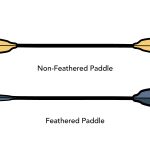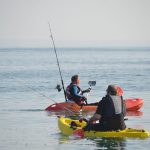The kayak paddle may not be the most interesting item of your kayaking gear, but it is just as essential as, for example, the kayak itself.
It is the thing that takes you from one place to another. Without a direction or goal, you will be aimlessly drifting without any means of progress. Using an improper size kayak paddle is a guarantee to make a kayaking adventure unpleasant, resulting in blisters, tiredness, and disappointment.
You may be curious about what size kayak paddle would be best for you.
Keep reading; we have a lot to discuss!
Benefits Of Right-Sized Paddles: Why Kayak Paddle Size Matters?
Selecting a kayak paddle is one of the most important choices you will have to make, but unfortunately, many novice kayakers end up with a paddle that is not suitable. A paddle that is the correct size for you to be able to easily grip and use will prevent exhaustion and will make paddling much more effective.
Having the right size kayak paddle is advantageous to enjoying the kayaking experience in many aspects.
Here are a few reasons why choosing the right kayak paddle length matters:
- Improved Control Over Your ‘Yak – Suitable paddle size makes it possible to utilize your paddle better. In return, that makes navigating the waters, controlling and steering your kayak, and maintaining balance easier, even for less experienced paddlers.
- More Comfort, More Fun – Comfort is an essential part of an enjoyable kayaking trip – and having the right paddle plays a major role in it. When you choose a proper paddle length, you minimize your chances of blisters, muscle strains, and fatigue. In short, you’re in for a more pleasant experience overall.
- Better Efficiency & Longer Paddling Sessions – Using the right type – and more importantly, size – of paddle ensures better efficiency with each stroke. You won’t need to put in as much effort into paddling and won’t experience fatigue as often. It can help you improve how long and how far you can go.
What Happens When You Use A Paddle That’s Too Long Or Too Short?
Not knowing the suitable size of kayak paddle you need could lead to having one that is either excessively long or too short for you, thus diminishing your capability to be comfortable.
Here are some common problems you might encounter with a wrong paddle size:
- Having less control over the kayak, making it go zig-zag, rather than tracking straight
- Experiencing fatigue and muscle soreness often
- Struggling to reach the water with the paddle blade and having to lean over to compensate for it
- Dealing with the additional weight of the paddle
- Hitting the sides of the kayak’s hull with your knuckles
- Having to put in more effort to maintain stability
- Developing blisters during longer paddling sessions
Making Your Choice Easier: Factors That Determine Kayak Paddle Size
The general guidelines for determining what size paddle for kayaking you need are pretty straightforward:
If you are taller in stature and have a wider kayak, then you will need to have a longer paddle.
Coming to a conclusion on what size kayak paddle is desired is a very subjective matter. All the aspects that need to be evaluated before selecting a kayak include your stature and how much space your torso needs, the size of the kayak and the kind of kayaking you do.
- Your Body Size – Your body size, namely your overall height and torso length, is arguably the biggest factor in kayak paddle size. As I said, the taller you are, the longer the paddle you need.
Most paddle size charts will include paddler’s height as the leading factor, but as you’ll see later, your torso height makes for a more accurate match.
- Kayak Width – The width of your kayak’s hull will be the second most important consideration when determining the correct of a kayak paddle. The wider your ‘yak, the longer your paddle; it’s that simple. Always measure the kayak’s widest point for the most accurate reading.
- Stroke Preference and Paddling Style – Stroke angle preference plays a major factor in kayak paddle selection – the high angle vs low angle debate. Do you prefer a high-angle paddling stroke that keeps the blade closer to the kayak’s side and generates more force?
Or do you like using a more horizontal, low-angle paddling stroke for longer days on the water? All else being equal, you would need a shorter paddle in the first scenario, with a shorter and wider blade shape.
And, a longer paddle in the second, with a longer and narrower paddles blades.
- Type Of Kayaking You Do – Another way to narrow down your paddle size options is to factor in the kind of kayaking you plan on doing – recreational, touring, performance, or whitewater. For instance, in rough waters and whitewater rapids, control is a priority; a shorter paddle fits the bill.
Longer touring kayaks call for longer paddles, as they help generate more stroke power. Recreational paddling falls somewhere in between.
- Seat Height – If you prefer a higher seating position – as kayak anglers typically do because it increases visibility and casting ability – know that it will affect your paddle angle and as a result your paddle’s size, as you will require a longer paddle.
Determine the recommended paddle size for you based on the factors discussed above, and then add roughly 10 centimeters. That will compensate for the extra distance from the water when kayak fishing.
What Size Do I Need For My Height?
To figure out what size is appropriate, measure the height of the torso, starting from the hip to the very end of the nose. A 230cm paddle is appropriate for kayakers of average stature. If you are 22 inches tall, you need an oar that is 180 centimeters long.
If the measurement of your body from the shoulders to hips is between 24 and 30 inches, then you should look for a paddle that is between 180 and 230 centimeters in length. If your body length is between 32 to 36 inches, a paddle that is between 220-250 centimeters can fit you well.
The correct kayak paddle for you is largely based on your body size, the size of your kayak, and your individual paddling style. Different people may have different opinions, but those should be your main considerations. The optimal strategy is to employ industry-established standard measurement units.
If you have been searching, the length of a kayak paddle increases at intervals of 10cm. This might not seem like a big boost, however it can have a major impact on your kayaking excursion.
It may not be immediately apparent but you will likely begin to recognize the effects over time as your body begins to feel the strain.
Hands-On Kayak Paddle Sizing
Those who are in a rush to get to the water can quickly configure the size of a paddle. Get into a regular paddle position and clasp the paddle with both hands. Ensure that your hands are two-thirds of the way from the paddle’s junction with the shaft.
Hold the paddle so that the length of it reaches to the end of your arm and put the first joint of your fingers on the top of the paddle. Do not tie more than one finger joint together when making a paddle or it may turn out shorter than intended.
Paddle Length
Your torso length is the most critical factor to take into consideration when selecting the right size of paddle, even though your height will influence it. If your torso is lengthy, then you should get a paddle that is also elongated.
To determine the length of your torso, bend your head down to locate the topmost vertebra. Place your hands on the hipbones and make sure your thumb is facing backwards. You should look at the distance between both of your thumbs.
Request that somebody measure the gap from the highest vertebra to the lower back region. Make sure you get the proper body measurements by rounding up to the closest inch. It makes sense, doesn’t it?
- 22 inches – try 180 cm paddle (you’ll often find this size in youths)
- 24 to 28 inches – Look for a paddle between 180 to 220 centimeters
- 34 to 38 inches – find a paddle that falls between 230 and 250 cm long
- If you’re 5 feet tall or shorter, your paddle length should be 210 and 240cm.
- If you’re 5.5 to 6 feet tall, your kayak paddle should be 220 to 260 feet long
Although it is beneficial to measure yourself to determine what type of paddle you should buy, having the chance to get a feel of the paddle in person is the best way to go. Hop into any kayak, take hold of some oars, and see which one feels the best.
Ensure you maintain the right stance while you are getting the measurements. If you take the precise measurements, you will have a good time swimming. If you make mistakes, you may have to put in extra effort in order to increase your pace.
This may result in the development of blisters.
Right Kayak Size For Kids
When selecting a kayak, an option you have is to pick a paddle based on size, even though a lot of kayaks are sold with kid-sized paddles. Choose wisely just as if it were for yourself. But there are critical factors to consider. Here are a few guidelines to follow:
- For kids under 4 feet, you should choose a 182 cm paddle
- Kids from 4 to 4.6 feet should choose 182 to 210 cm paddle
- Kids above 5 feet tall – follow the same guidelines as adults
Paddle Size Depends On The Width Of The Kayak
You should bear in mind that the breadth of a kayak is based on the size of the user when you purchase your kayak. Kayaks made for fishing are wider, thus providing more equilibrium when in water – this can be advantageous if you’re angling while upright.
The paddles you select should be in accordance with the dimensions of your kayak in order to guarantee a successful catch. If you have a touring kayak, you will require a shorter paddle due to its narrower shape. A wide kayak requires a longer paddle.
How To Determine Kayak Paddle Length For My Weight
The size of the paddle does not depend on your weight. As long as you employ the kayak for the aim it was manufactured for- pleasure trips, angling, or exciting white water adventures, you should feel at ease.
Kayak paddle size: low vs. high angle paddles
The type of kayaking you do will decide what size paddle you will require. If you’re a recreational kayaker of medium height, you need an average length oar with a low angled blade.
Someone who paddles at a steep angle would prefer a paddle with a shorter handle and a longer blade. This style allows them to perform athletic strokes. This style is typically present in those who go whitewater rafting or take part in kayaking competitions.
It might be wise to think about obtaining kayak paddles with a short shaft if yours is part of this group.
For those seeking a tranquil kayaking journey, a paddle with a small angle of attack is perfect. You may have concluded that it is optimal for lengthy trips spent fishing. To avoid becoming tired too quickly, pick a kayak that is longer but with a slimmer paddle.
If you become exhausted rapidly, you’ll return with less fish.
For a kayaker of average height, a kayak paddle that measures 210 cm to 220 cm is best when held in a high angle. Blade angles that are lower give a more comfortable experience for people who may be engaging in recreational or lengthy paddling activities.
Is It A Two-Piece Or Four-Piece?
Let’s face it: no fishing paddles are one piece. It’s either 2-piece or 4-piece. Be sure that the components contribute to the instructed size. A four-piece paddle can be great for backpacking trips.
Other Factors To Consider When Determining The Right Paddle Size
Symmetrical vs. asymmetrical blades
Blades that are unevenly shaped have a longer handle and possess an upturned edge. This helps to prevent the water pressure from remaining at the highest point of the knife and the handle from rotating in the hands.
Many inexpensive kayaks come equipped with symmetrically-shaped paddles, which are still effective when in use on a kayak. If your finances permit, you should put your money into uneven blades.
Size of the blade
A paddle with a big blade needs more strength in order to cut through the water. However, this does not suggest getting a bigger blade. If you possess a kayak that is shorter, you need to provide more strength when paddling.
This can be very exhausting on the shoulders and the entire body. If you don’t feel like confronting the issue, buying a kayak with a blade that is average or moderate sized but suitable for you could be a good option.
The Bottom Line
Now you know how to determine kayak paddle length. No matter if you paddle with a low angle or a high angle, you should look for a paddle that works best for you. In addition to that, think about the location where you would be kayaking and the best type of fishing for your situation.
Many starter kayak models come with paddles included, but these tend to have limited abilities.
If your paddle isn’t long enough, you may end up hitting your knuckles. If it’s too long, the additional oscillation rate will decrease control of your kayak. Be sure to take into account the materials used in the construction of your blade, as well as its design.
I am confident this guide will assist in deciding which product to buy. Once you calculate the facts, you’ll be pleased with the decision.




